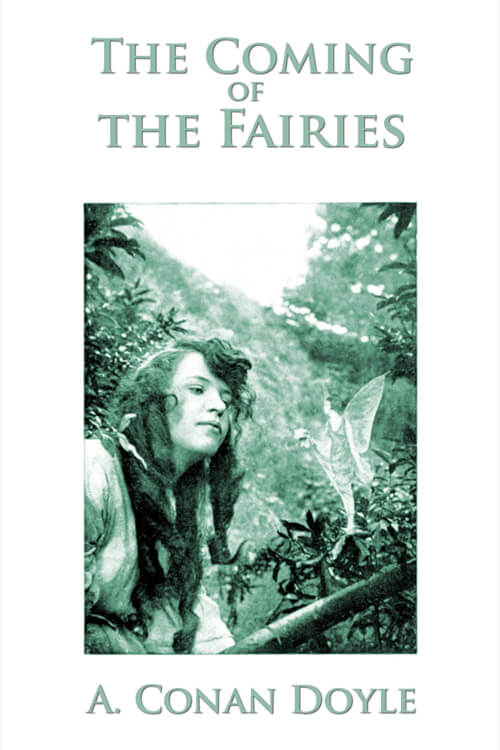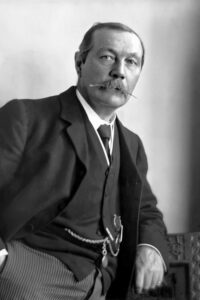
The Coming of the Fairies
The series of incidents outlined in this little volume represent either the most elaborate and ingenious hoax ever played upon the public, or else they constitute an event in human history that may in the future appear to have been epoch-making in its character. It is hard for the mind to grasp what the ultimate results may be if we have proved the existence upon the surface of this planet of a population that may be as numerous as the human race, which pursues its own strange life in its strange way, and which is only separated from ourselves by some difference of vibrations. We see objects within the limits that make up our color spectrum, with infinite vibrations, unused by us, on either side of them. If we could conceive a race of beings that were constructed in material that threw out shorter or longer vibrations, they would be invisible unless we could tune ourselves up or tone them down. It is exactly that power of tuning up and adapting itself to other vibrations that constitutes a clairvoyant, and there is nothing scientifically impossible, so far as I can see, in some people seeing that which is invisible to others. If the objects are indeed there, and if the inventive power of the human brain is turned upon the problem, it is likely that some sort of psychic spectacles, inconceivable to us at the moment, will be invented, and that we shall all be able to adapt ourselves to the new conditions. If high-tension electricity can be converted by a mechanical contrivance into a lower tension, keyed to other uses, then it is hard to see why something analogous might not occur with the vibrations of ether and the waves of light.
This, however, is mere speculation and leads me to the fact that early in May 1920 I heard, in conversation with my friend Mr. Gow, the Editor of Light, that alleged photographs of fairies had been taken. He had not seen them, but he referred me to Miss Scatcherd, a lady for whose knowledge and judgment I had considerable respect. I got in touch with her and found that she also had not seen the photographs, but she had a friend, Miss Gardner, who had done so. On May 13 Miss Scatcherd wrote to me saying that she was getting on the trail, and including an extract from a letter of Miss Gardner, which ran as follows. I am quoting actual documents in this early stage, for I think many would like a complete inside view of all that led up to so remarkable an episode. Alluding to her brother Mr. Gardner, she says:
“You know that Edward is a Theosophist, has been for years, and now he is mostly engaged with lecturing and other work for the Society—and although for years I have regarded him as bathed in error and almost past praying for, I now find a talk with him an inspiring privilege. I am so very thankful that I happened to be in Willesden when his bereavement took place, for it was so wonderful to watch him, and to see how marvelously his faith and beliefs upheld and comforted him. He will probably devote more and more of his time and strength to going about the country lecturing, etc.
“I wish you could see a photo he has. He believes in fairies, pixies, goblins, etc.—children, in many cases, really see them and play with them. He has gotten into touch with a family in Bradford where the little girl, Elsie, and her cousin, Frances, constantly go into the woods and play with the fairies. The father and mother are skeptical and have no sympathy with their nonsense, as they call it, but an aunt, whom Edward has interviewed, is quite sympathetic with the girls. Some little time ago, Elsie said she wanted to photograph them and begged her father to lend his camera. For long he refused, but at last, she managed to get the loan of it and one plate.
Read or download Book
Arthur Conan Doyle
Sir Arthur Ignatius Conan Doyle KStJ, DL (22 May 1859 – 7 July 1930) was a British writer and physician. He created the character Sherlock Holmes in 1887 for A Study in Scarlet, the first of four novels and fifty-six short stories about Holmes and Dr. Watson. The Sherlock Holmes stories are milestones in the field of crime fiction.
Doyle was a prolific writer; other than Holmes’s stories, his works include fantasy and science fiction stories about Professor Challenger, and humorous stories about the Napoleonic soldier Brigadier Gerard, as well as plays, romances, poetry, non-fiction, and historical novels. One of Doyle’s early short stories, “J. Habakuk Jephson’s Statement” (1884), helped to popularise the mystery of the Mary Celeste.
Name
Doyle is often referred to as “Sir Arthur Conan Doyle” or “Conan Doyle”, implying that “Conan” is part of a compound surname rather than a middle name. His baptism entry in the register of St Mary’s Cathedral, Edinburgh, gives “Arthur Ignatius Conan” as his given name and “Doyle” as his surname. It also names Michael Conan as his godfather. The catalogs of the British Library and the Library of Congress treat “Doyle” alone as his surname.
Steven Doyle, publisher of The Baker Street Journal, wrote: “Conan was Arthur’s middle name. Shortly after he graduated from high school he began using Conan as a sort of surname. But technically his last name is simply ‘Doyle’.” When knighted, he was gazetted as Doyle, not under the compound Conan Doyle.
Doyle’s first novels were The Mystery of Cloomber, not published until 1888, and The Unfinished Narrative of John Smith, published only posthumously, in 2011. He amassed a portfolio of short stories, including “The Captain of the Pole-Star” and “J. Habakuk Jephson’s Statement”, both inspired by Doyle’s time at sea. The latter popularised the mystery of the Mary Celeste and added fictional details such as that the ship was found in perfect condition (it had taken on the water by the time it was discovered), and that its boats remained on board (the single boat was missing). These fictional details have come to dominate popular accounts of the incident, and Doyle’s alternative spelling of the ship’s name as the Marie Celeste has become more commonly used than the original spelling.
Between 1888 and 1906, Doyle wrote seven historical novels, which he and many critics regarded as his best work. He also wrote nine other novels, and—later in his career (1912–29)—five narratives (two of novel length) featuring the irascible scientist Professor Challenger. The Challenger stories include his best-known work after the Holmes oeuvre, The Lost World. His historical novels include The White Company and its prequel Sir Nigel, set in the Middle Ages. He was a prolific author of short stories, including two collections set in Napoleonic times and featuring the French character Brigadier Gerard.
Doyle’s works for the stage include Waterloo, which centers on the reminiscences of an English veteran of the Napoleonic Wars and features a character Gregory Brewster, written for Henry Irving; The House of Temperley, the plot of which reflects his abiding interest in boxing; The Speckled Band, adapted from his earlier short story “The Adventure of the Speckled Band”; and an 1893 collaboration with J. M. Barrie on the libretto of Jane Annie.






